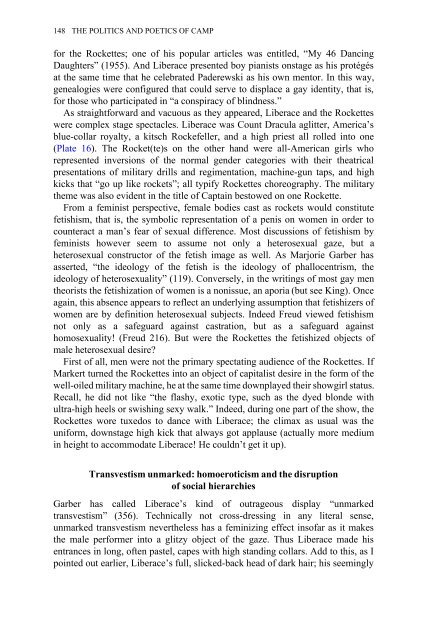Edited by Moe Meyer - Get a Free Blog
Edited by Moe Meyer - Get a Free Blog
Edited by Moe Meyer - Get a Free Blog
You also want an ePaper? Increase the reach of your titles
YUMPU automatically turns print PDFs into web optimized ePapers that Google loves.
148 THE POLITICS AND POETICS OF CAMP<br />
for the Rockettes; one of his popular articles was entitled, “My 46 Dancing<br />
Daughters” (1955). And Liberace presented boy pianists onstage as his protégés<br />
at the same time that he celebrated Paderewski as his own mentor. In this way,<br />
genealogies were configured that could serve to displace a gay identity, that is,<br />
for those who participated in “a conspiracy of blindness.”<br />
As straightforward and vacuous as they appeared, Liberace and the Rockettes<br />
were complex stage spectacles. Liberace was Count Dracula aglitter, America’s<br />
blue-collar royalty, a kitsch Rockefeller, and a high priest all rolled into one<br />
(Plate 16). The Rocket(te)s on the other hand were all-American girls who<br />
represented inversions of the normal gender categories with their theatrical<br />
presentations of military drills and regimentation, machine-gun taps, and high<br />
kicks that “go up like rockets”; all typify Rockettes choreography. The military<br />
theme was also evident in the title of Captain bestowed on one Rockette.<br />
From a feminist perspective, female bodies cast as rockets would constitute<br />
fetishism, that is, the symbolic representation of a penis on women in order to<br />
counteract a man’s fear of sexual difference. Most discussions of fetishism <strong>by</strong><br />
feminists however seem to assume not only a heterosexual gaze, but a<br />
heterosexual constructor of the fetish image as well. As Marjorie Garber has<br />
asserted, “the ideology of the fetish is the ideology of phallocentrism, the<br />
ideology of heterosexuality” (119). Conversely, in the writings of most gay men<br />
theorists the fetishization of women is a nonissue, an aporia (but see King). Once<br />
again, this absence appears to reflect an underlying assumption that fetishizers of<br />
women are <strong>by</strong> definition heterosexual subjects. Indeed Freud viewed fetishism<br />
not only as a safeguard against castration, but as a safeguard against<br />
homosexuality! (Freud 216). But were the Rockettes the fetishized objects of<br />
male heterosexual desire?<br />
First of all, men were not the primary spectating audience of the Rockettes. If<br />
Markert turned the Rockettes into an object of capitalist desire in the form of the<br />
well-oiled military machine, he at the same time downplayed their showgirl status.<br />
Recall, he did not like “the flashy, exotic type, such as the dyed blonde with<br />
ultra-high heels or swishing sexy walk.” Indeed, during one part of the show, the<br />
Rockettes wore tuxedos to dance with Liberace; the climax as usual was the<br />
uniform, downstage high kick that always got applause (actually more medium<br />
in height to accommodate Liberace! He couldn’t get it up).<br />
Transvestism unmarked: homoeroticism and the disruption<br />
of social hierarchies<br />
Garber has called Liberace’s kind of outrageous display “unmarked<br />
transvestism” (356). Technically not cross-dressing in any literal sense,<br />
unmarked transvestism nevertheless has a feminizing effect insofar as it makes<br />
the male performer into a glitzy object of the gaze. Thus Liberace made his<br />
entrances in long, often pastel, capes with high standing collars. Add to this, as I<br />
pointed out earlier, Liberace’s full, slicked-back head of dark hair; his seemingly


